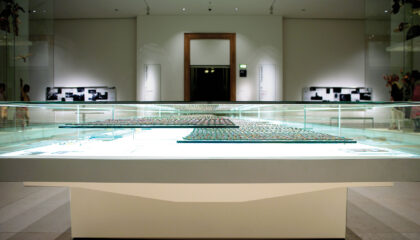The British Museum
Wellcome Trust Gallery
London, United Kingdom
2003
Dedicated to Sir Henry Wellcome (1853-1936), the great collector and benefactor of the museum, the Wellcome Trust Gallery contains the British Museum’s prestigious ethnographic collections. Inaugurated in 2003 as part of the celebrations marking the British Museum’s 250th anniversary, it was designed to host long-term exhibitions with objects displayed according to the concepts of modern social anthropology. The idea is to compare and contrast objects from various cultures and geographical areas, highlighting common human experience.
Exhibition design: Geoffrey Pickup, The British Museum Design Office, London
Area
892 m2
Length of exhibit fronts
42 m
The challenge
The structure of the galleries was intended to evoke cabinets of curiosities such as 17th century scholars and explorers would have used to show off their finds, and which many see as the precursors to the ethnographic museums of today. Display cases set against the wall are reminiscent of the original shelves of the cabinet, and a table in the middle of the room holds various objects for display, contemplation, or study, reminding one of an ancient scholarly sanctuary. The key challenge of this project, however, was the scale of the structures required: the wall cases stand 5 meters tall, while the center table spans 13 linear meters, entirely encased in glass.
The solution
The large doors of the wall display cases open almost effortlessly. To protect and conserve the delicate objects within, we fit the cases with centralized climate control systems to stabilize relative humidity. To compress the seals completely, a hexagonal shaft operates barrel-headed cams that rotate simultaneously to press the door frame to the striking surface. This system both achieves a tight seal and provides high security by mechanically locking the door at several points along its perimeter.
The central installation by Pharmacopoeia, called "Cradle to Grave," tells the story of an average man and woman told through the medication they have taken in their life and accompanied by photographs, documents and objects. The installation is displayed in the center table, which spans 13 linear meters, entirely encased in a glass bonnet. We developed an ingenious, patented opening system for the table, comprised of eight telescopic screws placed at intervals on either side, operated simultaneously by a transmission shaft to raise the long lid. This enables lifting the entire glass hood above the table’s legs so staff can easily reach objects in the display area. Goppion now holds a patent on this system.




